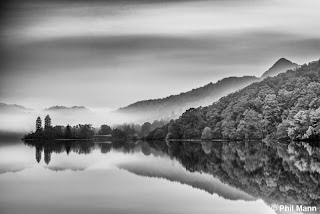It is hard to deny that I came late to the digital age; for a long time clinging on like a dinosaur to my medium format camera and Velvia. And so, while I still believe in trying to create my image 'in camera' as far as possible, I am beginning to come round to the idea that tools like Lightroom and Photoshop can be used to improve an image without altering the essential truth. One such example of this is the creation of panoramic images from a number of individual pictures stitched together and this was something I decided to try out in earnest whilst in Scotland recently.
6 images, 105 mm, portrait format
This picture of Glen Finglas dam was one of my first attempts and illustrates an important early lesson. One of the things that attracted me to this scene was the wonderful curving road which draws you in and helps create an impression of depth. Unfortunately, I composed the individual images to tightly - fine on their own but, when stitched together, the necessary crop all but eliminated the road. Such an important part of the composition, I had to resort to cloning a large area of foreground grass in order to retain more of the road. It's ok but, sadly, not what I had hoped for.
6 images, 58mm, portrait format
For the second picture shows Loch Achray shortly after sunrise and is the second of two attempts. At first, I used aperture priority feeling that it would allow me to operate more quickly but I realised that the changing exposure might make stitching seamlessly more difficult. The second attempt, therefore, was made using manual exposure ensuring a balanced exposure.
5 images, 70mm, portrait format
The final scene is also of Loch Achray, again just after sunrise but on a very different day. It is, I think the most successful of the three but might have benefited from a slightly wider angle to allow a bit more room.
I used the D800 for all three of these pictures which makes for some huge files (each one created a TIFF file in excess of 1Gb). Consequently, you need to be very patient - the processing is very memory intensive. What does help, is to make as many adjustments on the individual images before stitching and this is where Lightroom is a boon since you can make the adjustments to one and then sync the changes made to all of the others.
In addition to creating a wider view than normally possible, you avoid the distortion from an extreme wide angle lens and end up with an incredibly detailed and very big file which, in theory, should enable you to produce a really big print. The only problem I have now is paying for that big print and getting it mounted - oh, and the inevitable new disk to house all the huge files.





